Summer Weed Control in Arkansas
Gardening comes with a host of rewards and challenges. Some of the biggest challenges faced by gardeners are weeds and pests. No matter how bad weather conditions get for growing plants, weeds seem to grow undaunted. Weeds are tough performers able to survive and thrive in a wide range of growing conditions.
Fast Facts
- Learning to identify the weeds you have is often the first step to controlling them.
- If you can catch them as they are getting started, you may be able to limit their spread and return.
- Hoeing can be considered the best method for weed control, but there are also herbicides that can control them.
- If you do opt for chemical control, know there are differences in what can be sprayed around ornamentals, turf and edibles.
What types of summer weeds are common in Arkansas?
Summer weeds can be divided into annuals and perennials. While the annuals are just
here for one season, they often aggressively set seeds providing an unhappy return
the next season. Perennials can also set seeds, but they come back from their root
system as well, often making them more difficult to kill. Below is a list of common
summer weeds:
While Bermudagrass is a desired lawn grass, when it escapes into flower beds and vegetable gardens, it is a tenacious weed. It thrives in hot, dry conditions in full sun. It does not compete well in the shade. Bermudagrass spreads by rhizomes and if left unchecked, can outcompete flowers and vegetables. Make sure to give yourself a buffer zone of 6-12 inches between where your lawn ends and your vegetable and flower gardens begin.
Preplant Control
Make three or four applications of 41% ai glyphosate or higher at 2 to 3 quarts per
acre over
the growing season (May, July and September). Wait for regrowth before making the
next application. Using this method does not guarantee complete control. Tank mixing
with 24 fluid
ounces per acre of Fusilade II may improve control. Do not seed for 30 days after
applying
Fusilade II.
Selective Suppression
In zoysiagrass or tall fescue, use Fusilade II (fluazifop) at 6 fluid ounces per acre
plus Turflon 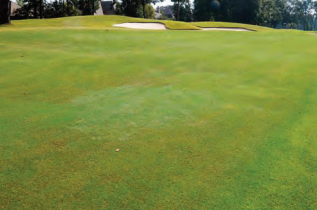 Ester at 32 fluid ounces per acre to suppress bermudagrass. Begin around June 1 and
repeat every four weeks unless the zoysiagrass has not recovered from the first application.
(Photo:bermudagrass in zoysiagrass. Click to enlarge.) In centipedegrass, Segment
(sethoxydim) may be used at 24 fluid ounces per acre to suppress bermudagrass, bahiagrass and other weedy grasses. Do not apply Segment sooner than three weeks after green
up and more than twice per season. Do not tank mix sethoxydim with other pesticides
or fertilizers.
Ester at 32 fluid ounces per acre to suppress bermudagrass. Begin around June 1 and
repeat every four weeks unless the zoysiagrass has not recovered from the first application.
(Photo:bermudagrass in zoysiagrass. Click to enlarge.) In centipedegrass, Segment
(sethoxydim) may be used at 24 fluid ounces per acre to suppress bermudagrass, bahiagrass and other weedy grasses. Do not apply Segment sooner than three weeks after green
up and more than twice per season. Do not tank mix sethoxydim with other pesticides
or fertilizers.
Chambers Bitters is the rabbit of the weed world. This annual weed doesn’t get growing until the soil temperature warms up, but when it starts, stand back. The compound leaves resemble a miniature mimosa tree.
The plant begins to flower and set seeds at a young age. The seeds are produced on the undersurface of the leaves. The plant grows upright and can get as tall as 4 feet or more if left untouched. It has a strong taproot, which makes it quite drought tolerant. The key to controlling this weed is to catch it early.
Crabgrass is a summer annual grassy weed that germinates when soil temperatures are approximately 60º F for 3-5 days. It begins flowering and setting seeds some years by late May and continues until a frost. Crabgrass is a common weed in lawns and flower beds which can quickly generate a seed stalk in between mowing.
In lawns, the most effective way to control crabgrass is to create a dense, healthy turf and/or use a pre-emergent herbicide. We typically don’t recommend using a pre-emergent herbicide in flowerbeds or vegetables, since these products can inhibit vegetable and flower seeds as well. It is shallow-rooted so pulls out easily or can be uprooted with a hoe.
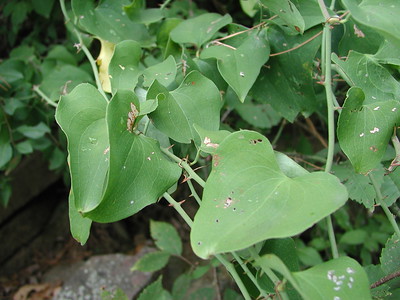
Greenbrier is a vining perennial weed that is covered in thorns. It has a deep root system which makes it quite difficult to kill. The plant is both heat and cold tolerant, but goes dormant with a killing frost.
Control
If you can wear protective clothing and pull it out from the root system it will help,
but rarely will you kill all the roots, and it will sprout back.
Spot spraying at the base of the plant with a glyphosate product (Round-up) can help. It will grow in sun or shade, and often intertwines with shrubs in the flower bed.
Common lespedeza is a very common summer weed that can easily choke out thin lawns.
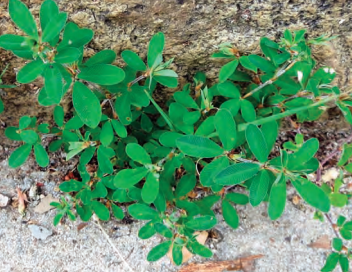 Lespedeza is a low growing annual weed with tough, wiry stems that forms a mat-like
growth. It has dark green trifoliate (arranged in threes) leaves. Lespedeza has a
semi-woody taproot and grows close to the ground, making it difficult to cut with
a mower. It flowers in late summer with tiny pink to purple, single flowers found
in leaf axils. Lespedeza is often an indicator of insufficient nitrogen fertilization.
Lespedeza is a low growing annual weed with tough, wiry stems that forms a mat-like
growth. It has dark green trifoliate (arranged in threes) leaves. Lespedeza has a
semi-woody taproot and grows close to the ground, making it difficult to cut with
a mower. It flowers in late summer with tiny pink to purple, single flowers found
in leaf axils. Lespedeza is often an indicator of insufficient nitrogen fertilization.
Control
2,4-D alone will not control lespedeza or white clover. Products containing metsulfuron,
fluroxypyr or triclopyr are very effective on most legumes. Escalade II, Confront
and metsulfuron (Manor, Mansion or Blade) are good lespedeza control products. When
using threeways (2,4-D + MCPP + dicamba), repeat applications are usually needed.
Celsius (thiencarbazone + iodosulfuron + dicamba) should be effective on lespedeza.
Ortho Chickweed and Oxalis Killer (8% triclopyr) is a good choice for homeowners.
Do not use this product on centipedegrass, St. Augustinegrass or bermudagrass.
Mulberry Weed is so named because the weeds look like tiny mulberry trees; however mulberries have smooth stems, while the weed has prominent hairs on the stems and the leaves. This annual weed forms a taproot and easily grow to three feet or more in height and produces flowers at the nodes, which quickly turn into seeds. Similar to the copious seeds on the chambers bitters, if left unchecked, it can easily set enough seeds to take over your garden.
Nutgrass is actually not a grass but a sedge, nutsedge to be more precise. Although it looks grass-like, nutsedge has a triangular stem, while grass stems are hollow and round. This is a tenacious perennial weed that forms a small underground nutlet or bulb-like structure. We have both yellow and purple nutsedge, along with a close relative Kyllinga.
These plants thrive in moist soils with full sun. Shade is a limiting factor. Eradication is difficult, so if you spot a new patch, don’t ignore it, but dig it out from the root system. They are a pest in lawns, flower beds and vegetable gardens.
Nutsedge, Purple Control
This is the most difficult sedge to control. Repeat applications will be needed. Monument
(trifloxysulfuron), Certainty (sulfosulfuron) and Dismiss South (sulfentrazone + imazethapyr)
provide temporary suppression of purple nutsedge. SedgeHammer+ (halosulfuron), while
slightly
less effective, is safe to use on all turfgrasses. Image 70 DG (imazaquin) is an effective
herbicide
for suppressing sedges in warmseason turfgrasses. Image may cause stunting of turfgrasses.
Nutsedge, Yellow Control
Not usually a problem in lawns. It is more common in ornamental beds and vegetable
gardens. SedgeHammer+, Image, Certainty, Monument, Dismiss and Dismiss South are all
effective for yellow nutsedge.
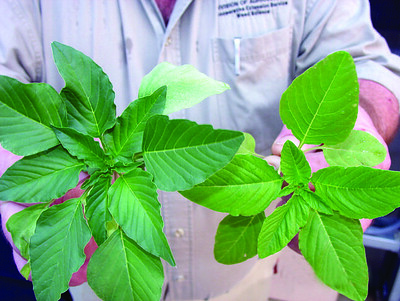
Pigweed is the common name for several annual species of weeds in the amaranth family, which are more of a problem in a vegetable garden than in lawns. These plants grow quickly and form tall bushy plants. They thrive in hot, dry weather and quickly respond to the fertilizer you are putting out for your vegetables, often out-competing the vegetables you are trying to grow.
They produce a prolific amount of seeds -a single large plant can mature 100,000–600,000
seeds, and can begin to set seeds within 6 weeks of emerging in your garden. If you
allow them to bloom, you can be assure of seeing them next year.
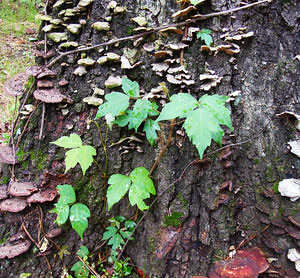
Poison Ivy is a terrible perennial weed that pops up in lawns and gardens across the state. This perennial vine or woody plant can take on a wide range of leaf shapes, but the leaves are always in groups of three. The entire plant is poisonous since all parts contain an oil called urushiol, which is what causes the irritating rash on folks who are allergic to it. Gardeners often overlook the plant in the winter when it is dormant, but dormant tissue still contains the oils in the roots and stems.
Do not burn the remains of poison ivy! This can be dangerous since the oils can escape in the smoke, and people who are highly allergic can suffer tremendously. Learn to recognize this plant and try to get it out from the roots, being sure to clean your gloves or tools after working around it, as the oil can be transferred from objects just like it can from the plant.
For more info visit our page on poison ivy identification, treatment and control
Spurge is a large family of plants in the euphorbia family, which exude a white, milky sap when the leaves are cut. Prostrate spurge is a mat forming annual weed that can spread up to two feet across from a central taproot. While it is a common weed across the board, it is even more prevalent in exposed, compacted soil in the sun, often appearing in the crevices of sidewalks and driveways. Although the flowers are small, the plant blooms continuously from late May through frost, setting plenty of seeds to come back next year.
Control
Manor, Mansion or Blade (metsulfuron) is the best spurge control treatment. Use only
in bermudagrass, centipedegrass, St. Augustinegrass, and zoysiagrass.
Virginia buttonweed is a common perennial weed in lawns that often resists chemical control. The plant forms a thick matted growth that is particularly aggressive in moist areas. It is a spreading broadleaf perennial with opposite leaves that often have a mottled, yellow appearance due to a virus that commonly infects the foliage, but doesn’t slow down its growth. It produces showy white star shaped blooms above ground, and uniquely it also has another set of flowers it produces below ground. Virginia buttonweed produces deep taproots and rhizomes that often start at the nodes. Rhizomes can be found as deep as several feet below the soil. If you spot this weed, the sooner you can control it, the better.
Control
Herbicides provide only temporary suppression of Virginia buttonweed. Products containing
fluroxypyr or triclopyr such as Escalade II or Momentum FX2 seem to be more consistent
than
the standard threeways. However, multiple applications of threeway (2,4-D + MCPP
+ dicamba) herbicides at intervals of three to six weeks do a fair job of suppressing
Virginia buttonweed. Consult label to determine the maximum number of applications
allowed per year.
There are a whole host of weeds which live and thrive in Arkansas gardens and lawns. Learning to recognize them and get rid of them when you see them is step one.
Some sound management practices will also be a step in the right direction:
- Maintain a dense lawn to outcompete lawn weeds
- Mulch flower and vegetable gardens
- Keep up with healthy garden management
No matter how good a gardener you are, no garden will ever be weed free 100% of the time, but ignorance is not bliss, it will simply allow your weeds to take over. So be diligent and watch for problems and handle them as quickly as you spot them.
For more information, download our publication on turfgrass weed control